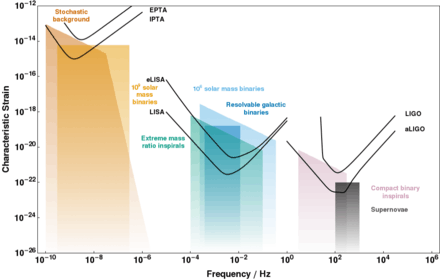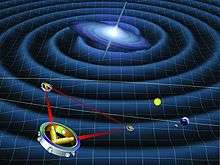Weber bar
A Weber bar is a device used in the detection of gravitational waves first devised and constructed by physicist Joseph Weber at the University of Maryland. The device consisted of multiple aluminium cylinders, 2 meters in length and 1 meter in diameter, antennae for detecting gravitational waves.[1]
Around 1968, Weber collected what he concluded to be "good evidence"[1] of the theorized phenomenon. However, his experiments were duplicated many times, always with a null result.
Such experiments conducted by Joseph Weber were very controversial, and his positive results with the apparatus, in particular his claim to have detected gravitational waves from SN1987A in 1987, were until recently widely considered discredited. Criticisms of the study have focused on Weber's data analysis and his incomplete definitions of what strength vibration would signify a passing gravitational wave. However, recent analysis has suggested that his claim may be in need of reassessment.[2][3]
Weber's first "Gravitational Wave Antenna" was on display in the Smithsonian Institution as part of "Einstein: a Centenary Exhibit" from March 1979 to March 1980.[4] A second is on display at the LIGO Hanford Observatory.[5]
Mechanism
These massive aluminium cylinders vibrated at a resonance frequency of 1660 hertz and were designed to be set in motion by gravitational waves predicted by Weber. Because these waves were supposed to be so weak, the cylinders had to be massive and the piezoelectric sensors had to be very sensitive, capable of detecting a change in the cylinders' lengths by about 10−16 meters.[1]
References
- 1 2 3 Lindley, David. "A Fleeting Detection of Gravitational Waves". Retrieved 2006-05-06.
- ↑ "Were gravitational waves first detected in 1987?". The physics arXiv blog. 2009-03-04. Retrieved 2009-03-04.
- ↑ Qadir, Asghar (2009). "Gravitational Wave Sources May Be "Further" Than We Think". arXiv:0903.0252
 [astro-ph.GA].
[astro-ph.GA]. - ↑ Einstein: A Centenary Exhibition. Edited by the National Museum of History and Technology. Washington, D.C.: Smithsonian Institution Press, 1979.
- ↑ "Resonant Bar Detector Dedicated at Hanford". The LIGO web newsletter. Retrieved 2012-03-29.
Further reading
- Weber, J. (1967), "Gravitational radiation", Physical Review Letters, 18 (13): 498–501, Bibcode:1967PhRvL..18..498W, doi:10.1103/PhysRevLett.18.498
- Weber, J. (1968), "Gravitational-wave-detector events", Physical Review Letters, 20 (23): 1307–1308, Bibcode:1968PhRvL..20.1307W, doi:10.1103/PhysRevLett.20.1307
- Weber, J. (1969), "Evidence for discovery of gravitational radiation", Physical Review Letters, 22 (24): 1320–1324, Bibcode:1969PhRvL..22.1320W, doi:10.1103/PhysRevLett.22.1320
- Weber, Joseph. How I discovered Gravitational Waves, Popular Science, Bonnier Corporation, May 1972, Vol. 200, No. 5, pp. 106–107 & 190–192, ISSN 0161-7370.

